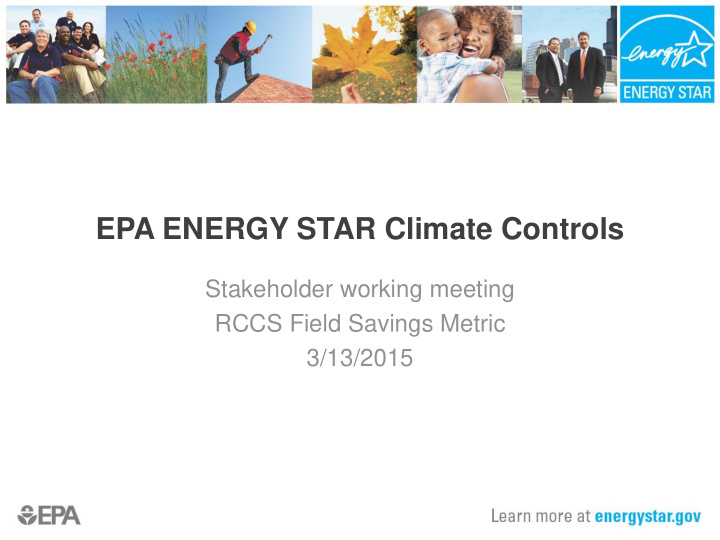



EPA ENERGY STAR Climate Controls Stakeholder working meeting RCCS Field Savings Metric 3/13/2015
Agenda • Reminder of what EPA is aiming for, purpose of the series of meetings (skip if no new participants) • Any administrative issues? • Old business – Data call odds and ends – Update on EPA provided code – Further thinking about resistance heat utilization • New business – Your questions and concerns <#>
Introduction – A New Approach • Large potential savings • New product types & business models emerge • Measuring RCCS savings being done today, but… – no standard methodology – savings claims vary widely <#>
Blend of local hardware and cloud services provides RCCS capabilities in the home in the cloud Thermostat Network device Consumer Two-way Remote Demand Occupancy communicatio Access response detection & n Independent Participatio automated Operational of link status Maintain n in 3 rd HVAC status comfort party (e.g. control reporting utility) Control Data services Consumer HVAC collection for feedback Equip. savings RCCS Boundary <#>
Program Outline • Recognition for RCCSs that save energy in the field • To earn the ENERGY STAR: – RCCS criteria that enables savings – Periodic reporting of savings • Product includes service component • ENERGY STAR Partner is service provider • Periodic field data – Calculate program emissions reductions – Serve as energy savings data for QPL <#>
Step 1: Metric • Ranks RCCSs based on field savings • Uses data from RCCS or publically available • Preserves consumer privacy • Protects proprietary information • Practical to calculate • Activities to date – Framework 11/5/14; San Francisco meeting 11/19/14 – Algorithmic framework 1/12/15; Stakeholder call 1/16/15 – Stakeholder call and next algorithmic framework, 1/30/15 <#>
Administrative concerns? • Anything we need to deal with? <#>
Old Business • Data call - a couple issues – Please send data to ICF (Doug Frazee) – Data anonymity: if we get 5 data points, will share with group. Otherwise, will discuss with those who provide data before we release – EPA standard practice in other specs: release anonymous data as long as we have at least 3 data points – Typo: page 2 still refers to 2 options for the regions, please ignore <#>
Old Business (continued) • EPA provided code update – Intend to create Python wrapper around code from ASHRAE 1050 RP (Inverse modeling toolkit) – Inputs will be CSV time-series data • Resistance heat utilization (RU) – Following last week’s discussion, resistance run time in numerator instead of compressor run time – Denominator would ideally be total heating run time, but is that available? – Standard terminology “emergency heat” is when the resistance heating is running without the compressor; t compressor + t emergency would be the total heating run time – Standard terminology “aux heat” is resistance heat with compressor – Current idea: calculate in 5 ° F bins from 0 ° F to 60 ° F, RU = t resistance / (t resistance + t compressor ) <#>
New Business – stakeholder topics • Heat pumps have COP above one usually down to at least 0 F, though they lose capacity • What about liquid return into compressor? Compressor lockout temperature – typically 0 F. • What about generic call for heat and system decides whether to do aux or compressor? • True that compressors have low temp switches, for example, and may not run when the thermostat calls for it. Low amount of time <#>
New Business – stakeholder topics • Similar for defrost cycles. Generally occur for temps below 40 F, and all the way down from there. There are many different mechanisms and algorithms. Worst around and just above freezing - once well below freezing, not much humidity in the air. • Running more aux rel to compressor may be helpful to reduce defrost and save energy – sounds like good for proprietary controllers <#>
New Business – stakeholder topics • From parking lot: Will providers use this method to make savings claims? Yes, with the comparison with the score of a “regular” thermostat. • What about programmatic savings? Yes, we hope so – but more data may be needed for that quality of estimate • Can algorithm be re-run with different baseline? – EPA will not have the data to do that – Providers might – But can also use temperature data from homes with non-smart thermostats to score the “average” home in a region <#>
New Business – stakeholder topics • Dual fuel heating systems – Very different from resistance heating back up – Current development is not intended to work for dual fuel systems – maybe harder than multi stage? – How common are dual fuel – less common than resistance backup <#>
New Business – stakeholder topics • Dual fuel heating systems – Very different from resistance heating back up – Current development is not intended to work for dual fuel systems – maybe harder than multi stage? – How common are dual fuel – less common than resistance backup • Back to resistance heating backup – How will we use it? – We don’t know yet, but we may know more once we see it <#>
Running parking lot • Will providers use this method to make savings claims? • Verification and gaming the system? • Does the customer base bias the metric results, aside from the qualities of the products? • Add on today’s parking lot items… <#>
Contact Information Abigail Daken EPA ENERGY STAR Program 202-343-9375 daken.abigail@epa.gov Doug Frazee ICF International 443-333-9267 dfrazee@icfi.com <#>
Recommend
More recommend